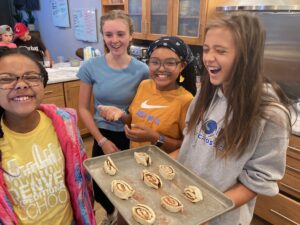Balancing Young Learners’ Media Consumption: Is There an App for That?

“Balancing Young Learners’ Media Consumption: Is There an App for That?” by Michael Levine was originally published on The Huffington Post.

America’s preschoolers spend about four hours a day consuming media, ranging from television (still No. 1) to Internet, digital video, and young gamer favorites such as Club Penguin, SesameStreet.org and Little Big Planet. Start with the recent explosion of touchscreen tablets and apps, add a healthy dose of new ‘i-tot’ products now marketed to parents with young kids, and presto — we have a whole new media ball game that has parents and educators in a tizzy. Which way is the explosion of interactive media offerings going to take us — towards more commercialization and consumption of a blizzard of new products or towards a more sensible media balance aided by some restraint, good guidance, and higher quality choices in the marketplace?
That is the $64,000 question giving many of us pause. In short, can the empty calories that now dominate far too many early media experiences be replaced with wholesome, fun, educational experiences? The ‘digitalization of childhood’ needs to be mediated in a way that children and their caregivers establish norms of behavior which impart the skills needed to compete in a global marketplace, but also practice the relational and deep thinking skills we will need to maintain excellence and equity in our society.
A recent post by Dan Donahoo, Wired Magazine’s ‘Geek Dad’, makes a passionate and compelling case for one part of this new media balancing act: the development of a new, more sustainable system of media creation for kids. He and others in the fledgling mission-based apps community are taking stock of the lessons learned from the consolidation of the TV and toy industries over the past two decades. They are trying to lay the groundwork for a different ecosystem marked by more creative diversity, higher quality, measurable educational impact, a new R and D pipeline, and a pricing structure to sustain innovation. Creators ranging from those deeply moved by America’s literacy and STEM crises such as Launchpad Toys’ Andy Russell — a creator of Toontastic (a great digital storytelling app — think Mad Libs for the digital age) to Gabriel Adauto and Jacob Klein, the co- founders of a remarkable math initiative called Motion Math(think “labyrinth for fractions”) are facing a largely inchoate system of creative talent flow, capital formation, marketing and distribution. Public media allies at production groups such as Sesame Workshop and Out of the Blue and distribution hubs supported by CPB and PBS are doing their best to keep up with changing dynamics, but so far there have been no blockbuster successes on the ed apps side.
The urgency for a new alliance to produce and promote the types of apps that Donahoo is hoping for and which Launchpad and the Motion Math team are already pioneering (often with popsicle sticks, gum and grad school grants as key parts of their start-up financing) — just became a bit more urgent. Last week, the Cooney Center released its most recent tracking study by Carly Shuler on the Apple iTunes “educational marketplace.” Released at the Consumer Electronics Show in Las Vegas’ “Kids@Play,” iLearn II: An Analysis of the Education Category on Apple’s App Store found that among products for the iPhone and iPad in the education category, apps for toddlers/preschoolers experienced the greatest growth (23 percent) in the last two years. Using a 2009 analysis conducted by the Center as a benchmark, the new market analysis examined nearly 200 top-selling education apps for the iPad and iPhone with the goal of understanding the education app market dynamics and trends. Among the key findings:
- Only 14 percent — one in seven — was tagged for intended school usage.
- The average price of children’s apps has risen by over $1 since 2009, but still is under $2.50.
- One hundred and nine different publishers were represented within the sample; 89 of these publishers were not represented in the sample 2 years ago.
Based on the findings, the report offers key recommendations for further growth and development of educational apps including:
- Manage the ‘app gap’ — According to a recent Common Sense Media study, 38 percent of low-income parents don’t know about apps, while 47 percent of higher income parents have downloaded apps for their children. Producers and educators should address this new ‘digital divide’ to ensure all children can access these new tools for learning.
- Create standards for products marketed as educational — No voluntary or regulatory standards currently exist around marketing products as educational. Industry leaders and policymakers should collaborate on developing a voluntary consumer education initiative to improve access to information about apps’ educational potential, proven impact and age appropriateness. If voluntary efforts prove unsuccessful a regulatory initiative may be appropriate within the next three years.
- Expand R&D to provide more research on educational value, equity of access, classroom practices, appropriate user interfaces, and to promote more robust connections between informal and classroom learning.
The Cooney Center is also working very closely with an alliance of philanthropic groups, publishers, creators and government leaders to create a new framework of analysis and tools for entering the games and digital learning marketplace. The Games and Learning Publishing Council, chaired by Dr. Milton Chen, formerly Executive Director of the George Lucas Educational Foundation and founder of Edutopia, and convened with generous support from the Bill and Melinda Gates Foundation and the John S. and James L. Knight Foundation, is now studying current market trends and promoting new public-privatepartnerships to incentivize media creators and distributors to drive a new generation digital products, including — and especially — educational apps, that will have lasting value in home, community and school settings. Together — industry, educators, and parents first and foremost — need to align interests in balancing our youngest children’s media diets right from the start!
—
Michael H. Levine is the founding director of the Joan Ganz Cooney Center at Sesame Workshop, an action research and innovation institute devoted to harnessing the potential of digital media to advance young children’s learning and development.






0 Comments
Leave a Comment
Your email address will not be published. All fields are required.